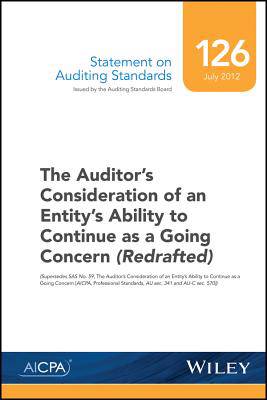
- Afhalen na 1 uur in een winkel met voorraad
- Gratis thuislevering in België vanaf € 30
- Ruim aanbod met 7 miljoen producten
- Afhalen na 1 uur in een winkel met voorraad
- Gratis thuislevering in België vanaf € 30
- Ruim aanbod met 7 miljoen producten
Statement on Auditing Standards, Number 126
The Auditor's Consideration of an Entity's Ability to Continue as a Going Concern
AicpaOmschrijving
As a result of its Clarity Project, the Auditing Standards Board (ASB) has issued Statement on Auditing Standards (SAS) No. 126, The Auditor's Consideration of an Entity's Ability to Continue as a Going Concern (Redrafted), to supersede SAS No. 59, The Auditor's Consideration of an Entity's Ability to Continue as a Going Concern, as amended (AICPA, Professional Standards, AU sec. 341 and AU-C sec. 570). SAS No. 126 does not change or expand SAS No. 59, as amended, in any significant respect.
The ASB has moved forward with the clarity redraft of SAS No. 59, as amended, so that it is consistent with the format of the other clarified SASs that were recently issued as SASs No. 122, Statements on Auditing Standards: Clarification and Recodification, No. 124, Financial Statements Prepared in Accordance With a Financial Reporting Framework Generally Accepted in Another Country, and No. 125, Alert That Restricts the Use of the Auditor's Written Communication.
However, the ASB decided to delay convergence with International Standard on Auditing 570, Going Concern, pending the Financial Accounting Standards Board's (FASB) anticipated development of accounting guidance addressing going concern. FASB issued an exposure draft, Going Concern, in October 2008, but based on recent decisions, FASB has divided the project into two separate and distinct phases. As a result, FASB projects to issue an exposure draft that addresses Phase 1, "The Liquidation Basis of Accounting," in the second quarter of 2012, and to reissue an exposure draft that addresses Phase II, "Going Concern," in the fourth quarter of 2012.
SAS No. 126 addresses the auditor's responsibilities in an audit of financial statements with respect to evaluating whether there is substantial doubt about the entity's ability to continue as a going concern. This SAS applies to all audits of financial statements regardless of whether the financial statements are prepared in accordance with a general purpose or a special purpose framework1. This SAS does not apply to an audit of financial statements based on the assumption of liquidation (for example, when [a] an entity is in the process of liquidation, [b] the owners have decided to commence dissolution or liquidation, or [c] legal proceedings, including bankruptcy, have reached a point at which dissolution or liquidation is probable).2
Alleen bij Standaard Boekhandel
Beoordelingen
We publiceren alleen reviews die voldoen aan de voorwaarden voor reviews. Bekijk onze voorwaarden voor reviews.












